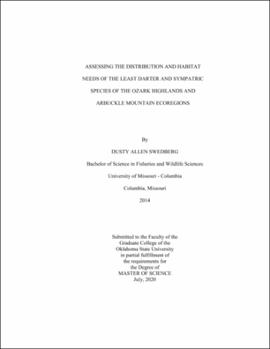| dc.contributor.advisor | Brewer, Shannon | |
| dc.contributor.author | Swedberg, Dusty Allen | |
| dc.date.accessioned | 2021-02-22T22:41:25Z | |
| dc.date.available | 2021-02-22T22:41:25Z | |
| dc.date.issued | 2020-07 | |
| dc.identifier.uri | https://hdl.handle.net/11244/328674 | |
| dc.description.abstract | There are more than 700 freshwater fish species considered vulnerable, threatened, or endangered making fish one of the most imperiled taxa in North America. Several of these species are found exclusively or primarily in lotic or semi-lotic systems. The hierarchical nature of lotic systems convolutes the quantification of species-habitat relationships necessary for development of successful management or conservation strategies. This hierarchical nature means it is fundamentally important to understand population persistence and patch dynamics at multiple spatial and temporal scales. Groundwater dependent streams often have unique assemblages adapted to their unique thermal and physicochemical conditions. The Least Darter (Etheostoma microperca) is an isolated spring-obligate species with disjunct southern populations in the Ozark Highlands and Arbuckle Uplift ecoregions. Though Least Darter are considered a spring-associated species, the habitat conditions which regulate their distributions are relatively unknown at all spatial and temporal scales. Understanding these relationships will be integral for developing management and monitoring strategies. I sampled habitat at coarse (reach) and fine (sub-reach) scales in the Ozark Highlands and Arbuckle Uplift ecoregions of Oklahoma in 2018 and 2019. At the reach scale, Least Darter and Southern Redbelly Dace occupancy probabilities are inversely related to temperature, whereas Redspot Chub and Smallmouth Bass increase with increases in drainage area. Furthermore, Southern Redbelly Dace and Smallmouth Bass sub-adult occupancy were influenced by sample year. In addition to the reach-scale occupancy, sub-reach observations were made to determine fine-scale Least Darter habitat associations. A reach in the Arbuckle Uplift and a reach in the Ozarks Highlands were sampled in winter and summer to determine Least Darter seasonal patch use. Our fine-scale observations showed Least Darter are generally associated with microhabitats containing fine substrates and use shallower higher-velocity areas with less vegetation in winter when compared to summer. The results of this study may be used to help develop year-round baseflow guidelines that support necessary groundwater inputs for these species. The development of such guidelines will be integral in maintaining variable yet suitable thermal and physical conditions for groundwater associated species to persist in these lotic environments. | |
| dc.format | application/pdf | |
| dc.language | en_US | |
| dc.rights | Copyright is held by the author who has granted the Oklahoma State University Library the non-exclusive right to share this material in its institutional repository. Contact Digital Library Services at lib-dls@okstate.edu or 405-744-9161 for the permission policy on the use, reproduction or distribution of this material. | |
| dc.title | Assessing the distribution and habitat needs of the Least Darter and sympatric species of the Ozark Highlands and Arbuckle Mountain ecoregions | |
| dc.contributor.committeeMember | Echelle, Anthony | |
| dc.contributor.committeeMember | Halihan, Todd | |
| osu.filename | Swedberg_okstate_0664M_16860.pdf | |
| osu.accesstype | Open Access | |
| dc.type.genre | Thesis | |
| dc.type.material | Text | |
| thesis.degree.discipline | Natural Resource Ecology and Management | |
| thesis.degree.grantor | Oklahoma State University | |
